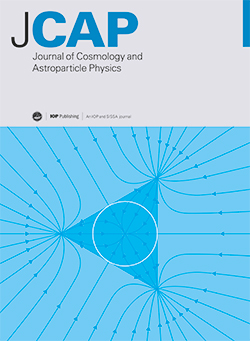Neural simulation-based inference of the neutron star equation of state directly from telescope spectra
IF 5.3
2区 物理与天体物理
Q1 ASTRONOMY & ASTROPHYSICS
Journal of Cosmology and Astroparticle Physics
Pub Date : 2024-09-02
DOI:10.1088/1475-7516/2024/09/009
引用次数: 0
Abstract
Neutron stars provide a unique opportunity to study strongly interacting matter under extreme density conditions. The intricacies of matter inside neutron stars and their equation of state are not directly visible, but determine bulk properties, such as mass and radius, which affect the star's thermal X-ray emissions. However, the telescope spectra of these emissions are also affected by the stellar distance, hydrogen column, and effective surface temperature, which are not always well-constrained. Uncertainties on these nuisance parameters must be accounted for when making a robust estimation of the equation of state. In this study, we develop a novel methodology that, for the first time, can infer the full posterior distribution of both the equation of state and nuisance parameters directly from telescope observations. This method relies on the use of neural likelihood estimation, in which normalizing flows use samples of simulated telescope data to learn the likelihood of the neutron star spectra as a function of these parameters, coupled with Hamiltonian Monte Carlo methods to efficiently sample from the corresponding posterior distribution. Our approach surpasses the accuracy of previous methods, improves the interpretability of the results by providing access to the full posterior distribution, and naturally scales to a growing number of neutron star observations expected in the coming years.基于神经模拟直接从望远镜光谱推断中子星状态方程
中子星为研究极端密度条件下的强相互作用物质提供了一个独特的机会。中子星内部错综复杂的物质及其状态方程并不直接可见,但却决定了质量和半径等体积属性,从而影响恒星的热X射线辐射。然而,这些辐射的望远镜光谱也会受到恒星距离、氢柱和有效表面温度的影响,而这些因素并不总能得到很好的约束。在对状态方程进行稳健估计时,必须考虑到这些干扰参数的不确定性。在这项研究中,我们开发了一种新方法,首次能够直接从望远镜观测结果中推断出状态方程和干扰参数的完整后验分布。这种方法依赖于神经似然估计的使用,其中归一化流使用模拟望远镜数据的样本来学习中子星光谱作为这些参数函数的似然性,再结合哈密尔顿蒙特卡洛方法从相应的后验分布中有效地采样。我们的方法超越了以往方法的准确性,通过提供完整的后验分布提高了结果的可解释性,并能自然地扩展到未来几年预期的越来越多的中子星观测。
本文章由计算机程序翻译,如有差异,请以英文原文为准。
求助全文
约1分钟内获得全文
求助全文
来源期刊

Journal of Cosmology and Astroparticle Physics
地学天文-天文与天体物理
CiteScore
10.20
自引率
23.40%
发文量
632
审稿时长
1 months
期刊介绍:
Journal of Cosmology and Astroparticle Physics (JCAP) encompasses theoretical, observational and experimental areas as well as computation and simulation. The journal covers the latest developments in the theory of all fundamental interactions and their cosmological implications (e.g. M-theory and cosmology, brane cosmology). JCAP''s coverage also includes topics such as formation, dynamics and clustering of galaxies, pre-galactic star formation, x-ray astronomy, radio astronomy, gravitational lensing, active galactic nuclei, intergalactic and interstellar matter.
 求助内容:
求助内容: 应助结果提醒方式:
应助结果提醒方式:


